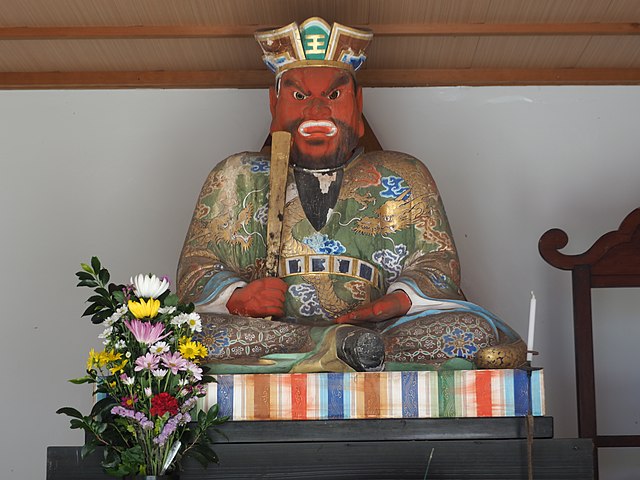A hu is a flat scepter originating from China, where they were originally used as narrow tablets for recording notes and orders. They were historically used by officials throughout East Asia, including Japan, Korea, Ryukyu, and Vietnam. They are known as shaku in Japan, and are worn as part of the sokutai ceremonial outfit. They continue to be used in Daoist and Shinto ritual contexts in some parts of East Asia.
Fan Zhongyan, a Chancellor of the Northern Song Dynasty, holding a hu in this portrait
Han dynasty stone relief of scholar-officials with an early hu.
Statue of Yama bearing a shaku; Hino, Shiga, Japan
An ivory hu, Ming Dynasty; Jiangxi Provincial Museum
The sokutai (束帯) is a traditional Japanese outfit worn only by courtiers, aristocrats and the emperor at the Japanese imperial court. The sokutai originated in the Heian period, and consists of a number of parts, including the ho, shaku (笏), a flat ritual baton or sceptre, and the kanmuri (冠), a cap-shaped black lacquered silk hat with a pennon.
Emperor Akihito wore the imperial sokutai Kōrozen no Gohō [ja] at the enthronement ceremony in November 1990.
Newly-wed Emperor Naruhito, then Crown Prince, wearing the princely sokutai Ōni no Hō [ja] and holding a shaku, 9 June 1993





![Emperor Akihito wore the imperial sokutai Kōrozen no Gohō [ja] at the enthronement ceremony in November 1990.](https://upload.wikimedia.org/wikipedia/commons/thumb/1/1a/Emperor_Akihito_199011_1.jpg/428px-Emperor_Akihito_199011_1.jpg)
![Newly-wed Emperor Naruhito, then Crown Prince, wearing the princely sokutai Ōni no Hō [ja] and holding a shaku, 9 June 1993](https://upload.wikimedia.org/wikipedia/commons/thumb/6/66/Emperor_Naruhito_and_Empress_Masako_in_formal_wedding_robes.jpg/640px-Emperor_Naruhito_and_Empress_Masako_in_formal_wedding_robes.jpg)